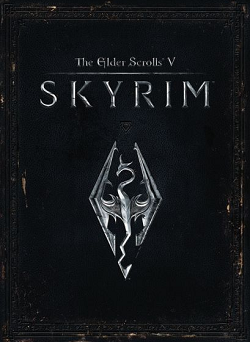The Elder Scrolls is a series of action role-playing video games primarily developed by Bethesda Game Studios and published by Bethesda Softworks. The series focuses on free-form gameplay in an open world. Most games in the series have been critically and commercially successful, with The Elder Scrolls III: Morrowind (2002), The Elder Scrolls IV: Oblivion (2006) and The Elder Scrolls V: Skyrim (2011) all winning Game of the Year awards from multiple outlets. The series has sold more than 59 million copies worldwide.

The Elder Scrolls III: Bloodmoon is the second expansion pack for the 2002 video game The Elder Scrolls III: Morrowind, developed by Bethesda Game Studios and released for Windows in 2003. The expansion was later released as part of the Morrowind: Game of the Year Edition for the Xbox in 2004. The expansion adds a landmass to the game, Solstheim, a setting modelled on Norse mythology. The primary questline of Bloodmoon involves the investigation of the Bloodmoon Prophecy that foretells the return of the demigod Hircine. A secondary features a new faction, the East Empire Company, which tasks the player to establish a mining colony. Bloodmoon also provides the player with the ability to become a werewolf, a feature closely embedded in the main storyline and quests. The expansion features more detailed environments, including weather shaders such as snowfall and blizzards.

The Elder Scrolls III: Morrowind is a 2002 action role-playing game developed by Bethesda Game Studios and published by Bethesda Softworks. It is the third installment in The Elder Scrolls series, following 1996's The Elder Scrolls II: Daggerfall, and was released for Microsoft Windows and Xbox. The main story takes place on Vvardenfell, an island in the Dunmer province of Morrowind, part of the continent of Tamriel. The central quests concern the demigod Dagoth Ur, housed within the volcanic Red Mountain, who seeks to gain power and break Morrowind free from Imperial reign.

The Elder Scrolls IV: Oblivion is a 2006 action role-playing game developed by Bethesda Game Studios, and co-published by Bethesda Softworks and 2K Games. It is the fourth installment in The Elder Scrolls series, following 2002's The Elder Scrolls III: Morrowind, and was released for Microsoft Windows and Xbox 360 in 2006, followed by PlayStation 3 in 2007. Taking place within the fictional province of Cyrodiil, the game's main story focuses on the player character's efforts to thwart a fanatical cult known as the Mythic Dawn that plans to open portal gates to a demonic realm known as Oblivion.

Jeremy Soule is an American composer of soundtracks for film, television, and video games. He has composed soundtracks for over 60 games and over a dozen other works during his career, including The Elder Scrolls, Guild Wars, Icewind Dale, and the Harry Potter series.

Todd Andrew Howard is an American video game designer, director, and producer. He serves as director and executive producer at Bethesda Game Studios, where he has led the development of the Fallout and The Elder Scrolls series. He was also the game director for Starfield.
Emil Pagliarulo is an American video game designer who works at Bethesda Game Studios.

The Elder Scrolls V: Skyrim is a 2011 action role-playing game developed by Bethesda Game Studios and published by Bethesda Softworks. It is the fifth main installment in The Elder Scrolls series, following The Elder Scrolls IV: Oblivion (2006), and was released worldwide for Microsoft Windows, PlayStation 3, and Xbox 360 on November 11, 2011.

Creation Engine is a 3D video game engine created by Bethesda Game Studios based on the Gamebryo engine. The Creation Engine has been used to create role-playing video games such as The Elder Scrolls V: Skyrim, Fallout 4, and Fallout 76. A new iteration of the engine, Creation Engine 2, was used to create Starfield. The Creation Engine has been tailor-made for large-scale open-world RPGs.
"I used to be an adventurer like you. Then I took an arrow in the knee...", or simply "arrow in the knee", is an Internet meme that originated from The Elder Scrolls V: Skyrim, an action role-playing video game developed by Bethesda Game Studios and published by Bethesda Softworks. Originally a procedurally generated line of dialogue conceived by Senior Bethesda game designer Emil Pagliarulo and spoken by non-player characters (NPCs) who act as guards, the phrase became unexpectedly popular among Skyrim players. The phrase and its variations, such as "arrow to the knee", have since found popular reference outside of the game's original context, as well as media unrelated to The Elder Scrolls franchise.

The Elder Scrolls V: Skyrim – Dawnguard is a downloadable content add-on for the action role-playing open world video game The Elder Scrolls V: Skyrim. It was developed by Bethesda Game Studios and published by Bethesda Softworks. The Xbox 360 version of Dawnguard was launched in English-speaking territories on June 26, 2012, and in France, Germany, Italy, and Spain in mid-July 2012. It was released on Microsoft Windows via Steam on August 2, 2012. Due to performance issues, the PlayStation 3 release of Dawnguard was delayed until February 26, 2013.

The Greatest Video Game Music, performed by the London Philharmonic Orchestra, features classical orchestrations of video game themes including those from Super Mario Bros., Call of Duty, Metal Gear Solid, Final Fantasy, Halo, World of Warcraft, Angry Birds and many more. A sequel, The Greatest Video Game Music 2, was released a year later.

The Elder Scrolls V: Skyrim – Dragonborn is the third and final add-on for the action role-playing open world video game The Elder Scrolls V: Skyrim. It was developed by Bethesda Game Studios and released by Bethesda Softworks on the Xbox Live Marketplace on December 4, 2012. The Microsoft Windows version was released on February 5, 2013, and the PlayStation 3 version was released on February 12, 2013.

The Elder Scrolls V: Skyrim – Hearthfire is the second downloadable content add-on for the action role-playing open world video game The Elder Scrolls V: Skyrim. The game was developed by Bethesda Game Studios and published by Bethesda Softworks. The Xbox 360 version of Hearthfire launched on September 4, 2012. It was released on Microsoft Windows via Steam on October 5, 2012. It was released for the PlayStation 3 on February 19, 2013, in North America and February 20, 2013, in Europe.

Judith de los Santos, known professionally as Malukah, is a Mexican composer and singer-songwriter known for her cover versions of music from video games or TV series and movies, which she publishes on YouTube. She became known to an international audience when a video of her cover of the song The Dragonborn Comes from the game The Elder Scrolls V: Skyrim became a viral video in November 2011. Since then she has contributed to several video game soundtracks, composed and produced original music, and performed live.
Skyrimmodding refers to the community-made modifications for the 2011 fantasy role-playing video game The Elder Scrolls V: Skyrim. One of the most modded video games of all time, it has nearly 70,000 mod submissions on Nexus Mods and 28,000 in the Steam Workshop. Many of these mods were created for utility reasons, patching numerous bugs left in the game by Bethesda Softworks, while also improving the game's usability and character movement. Other mods add new quests and characters, or update the game's graphics and animations. As the vanilla game has a reputation for outdated mechanics, it is common for players to mod Skyrim even prior to their first playthrough.
"Dragonborn" is the theme song for the soundtrack of the 2011 role-playing video game The Elder Scrolls V: Skyrim from Bethesda Softworks, composed by the American composer Jeremy Soule. The composition is Nordic-influenced classical in style and features a chorus singing lyrics in a fictional language, Dragon-tongue, that was created by Emil Pagliarulo for the game. The composition borrows heavily from "Nerevar Rising", the theme from The Elder Scrolls III: Morrowind, as well as elements from music in The Elder Scrolls IV: Oblivion, both of which were also composed by Soule. "Dragonborn" was lauded by critics and audiences alike. It is featured in orchestral performances and spawned numerous covers, many of which combine the song with an in-game, English-language composition "The Dragonborn Comes". One such cover, by Lindsey Stirling and Peter Hollens, holds the Guinness World Record for most viewed cover version of a video game soundtrack.












